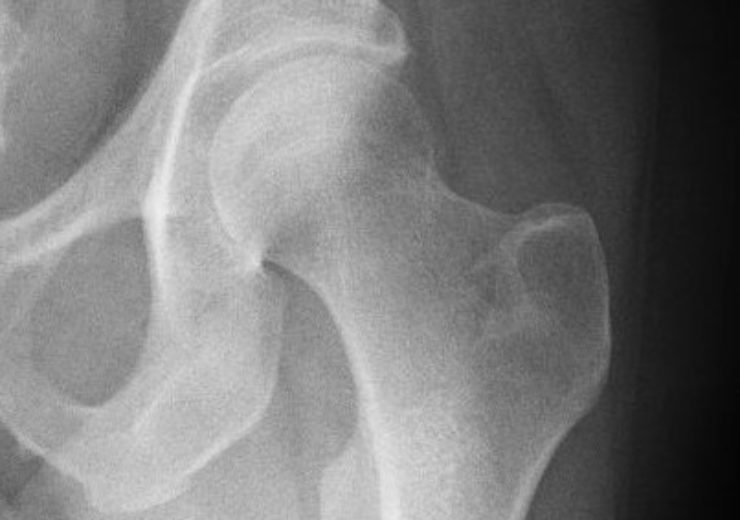X-Bolt is the first and only company to have conducted such rigorous clinical testing prior to commercial launch of its X-BOLT hip fixture device

Image: hip fracture fixation trial shows low cut-out rates for X-BOLT Device. Photo: Courtesy of Scuba-limp/Wikipedia.org
X-BOLT Orthopaedics, a leading medical device company, today announced preliminary results from the largest ever multi-centre randomised controlled trial comparing extracapsular hip fracture fixation devices, known as World Hip Trauma Evaluation 4 (WHITE4). The trial was conducted by Oxford University and supported by NIHR Oxford Biomedical Research Centre.
X-Bolt is the first and only company to have conducted such rigorous clinical testing prior to commercial launch of its X-BOLT hip fixture device. The headline results, presented at the British Orthopaedic Association in Liverpool yesterday, demonstrated the lowest ever ‘cut-out’ rate for a hip fixation device, achieving just 0.8% in a population of 476 patients. The study also showed that the X-BOLT device performed as well as the hip sliding screw (SHS) device with respect to EuroQol 5 Dimension Score (EQ-5D), a validated measure of health-related quality of life, as well as patient mortality, residential status, revision surgery and radiographic measures.
A 100-patient randomised pilot study published in 2016, known as ‘WHITE1’ at the University of Warwick showed a zero (0%) re-operation rate with the X-BOLT device, versus a 6% reoperation rate with the sliding hip screw in unstable inter trochanteric hip fractures (Bone and Joint Journal 2016; 98-B: 686-9).
‘Cut-out’ is a failure of implant anchorage which causes the implant or screw to literally ‘cut-out’ of the bone and into the hip joint. Fixation failure due to ‘cut-out’ is the main cause of re-operation resulting in increased hospital treatment costs. X-BOLT’s simple yet innovative mechanism for anchorage to the bone utilises wings that expand in situ to offer a rotationally stronger and more secure femoral bone anchorage than traditional screw fixation.
Recruitment for WHITE4 commenced in June 2016 and involved over 1000 patients in 10 centres throughout the UK, collaborating with the Orthopaedic Trauma Society, including Oxford, Northumbria, Leicester, Newcastle, South Tees, Frimley Park, Wexham, Coventry, Bristol and Portsmouth. Patients were randomised at the time of surgery to receive either a gold standard sliding hip screw (SHS) device or X-BOLT. Follow-up for all patients occurred at baseline, 4 weeks, 4 months and one year following surgery.
Dr. Brian Thornes, CEO of X-BOLT Orthopaedics said, “We are delighted that the X-BOLT has been so thoroughly investigated in such high quality independent research as the WHITE1 and WHITE 4 trials showing the lowest cut-out rates of any device on the market, mirroring its proven superior performance in biomechanical testing. Given the high volume of hip fractures and an ever-aging population, the X-BOLT is set to revolutionise hip fracture fixation.”
Professor Griffin, Chief Investigator for WHITE 4, based at Nuffield Department of Orthopaedics, Rheumatology and Musculoskeletal Sciences (NDORMS), University of Oxford said, “WHITE 4 was a highly successful trial which has set the benchmark for the entry of orthopaedic devices into clinical practice. I have been delighted to work with X-BOLT Orthopaedics over a number of years to provide outstanding quality research around the use of this device. It sets the best of standards for other companies to aspire to, particularly with a view towards the new regulations for devices coming into force in Europe early next year.”
Approximately 1.6 million hip fractures occur worldwide each year and due to an aging population, it is expected this number could reach 6 million by 2050. Each hip fracture episode costs approximately $40,000 (£30,000) in health and social costs. Loss of mobility and independence among hip fracture survivors is profound; less than 50% regaining their previous function and 33% being totally dependent or in a nursing home a year later. Reoperations occur in about 3-6% of patients, resulting in additional costs of approximately $50,000 (£35,000). Reducing the re-operation rate provides a significant opportunity for hospitals and governments to greatly reduce 30-day readmissions and overall healthcare costs, notwithstanding the benefits to patients by improving their quality of life.
